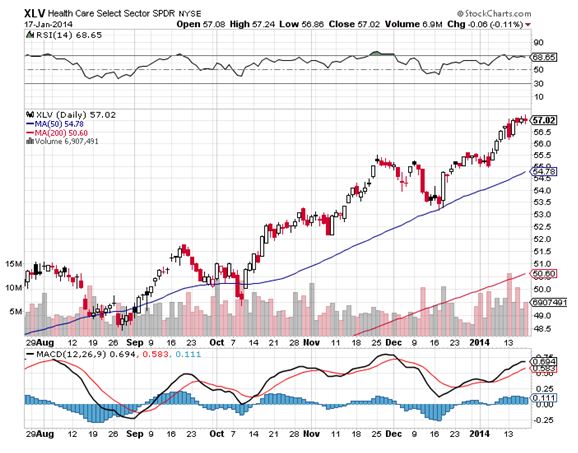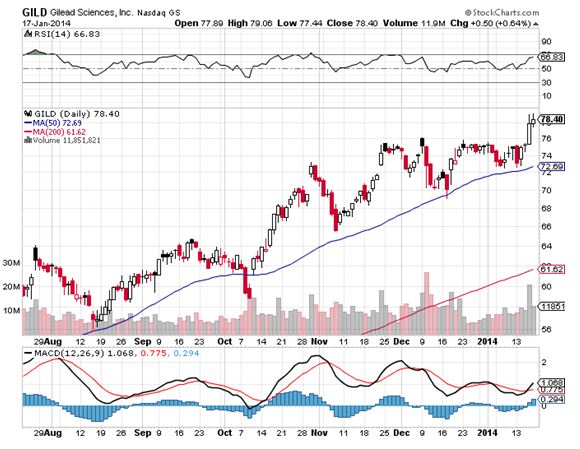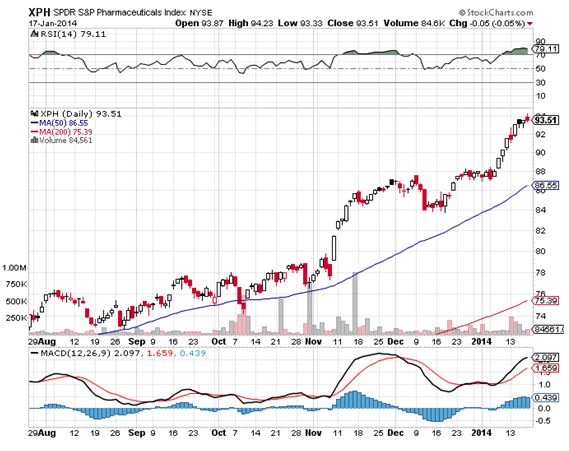January 22, 2014
By: John Thomas, “The Mad Hedge Fund Trader”

The last time I saw a move this healthy was back in the nineties, when a perfect trifecta of the internet going mainstream, cheap graphical user interface enabled personal computers, and an easy to use World Wide Web conspired to create a Dotcom boom and send risk assets everywhere ballistic.
Sure, the advent of cheap domestic energy unleashed by the fracking and horizontal drilling of natural gas is a game changer. But that isn’t enough to suddenly convert every investor from a pessimist to an optimist, a Cassandra to a Pollyanna, or a bear to a bull. So what else is helping to send stocks ever Northward?
Fortunately, I brought along an abacus with me to my high altitude retreat. So I ran a few numbers. Approximately 18% of US GDP is derived from the health care industry in some form or another. In Europe they spend only 8%, live longer, and certainly eat better food (I spent two months field testing it last summer).
So what happens when America’s Affordable Care Act, otherwise known as Obamacare, brings our spending down to European levels? The savings would amount to 10% of GDP, or $1.6 trillion. That is a handsome amount of change.
Where would all of this money go? The short answer is: to you and me. To be precise, I get half, and you get half, which works out to $800 billion for each of us, per year.
The reality is a little more complicated than that. We are not going to get our new found wealth in unmarked bills stuffed in a duffle bag left at a dead drop in the middle of the night. Rather, the payoff will come in an indirect form. We will get better quality health care for less money, and more of us will get it, some 48 million to be precise. Oh, and we get to live longer too.
What are we going to do with this windfall? Buy stocks, and lots of them. At least that’s what the stock market thinks. Hence, last year’s ballistic move in equities. This year could be just as good.
If fact, we will be buying a lot of everything, which is why the auto industry is on fire, real estate is recovering, yet the bond market hasn’t crashed. This amount of money hitting the financial system over the coming decade could well be the appetizer to an investment “golden age” during the 2020’s.
This is fabulous news for asset owners of all stripes, and pretty good for everyone else as well. Companies with rising share prices are much more likely to hire and expand capital investment than those with falling ones, raising standards of living.
The way this happens is what makes Obamacare so interesting, unlike the purely government sponsored plans now in operation in Europe and Asia. It does this with a heavy reliance on the private sector to unleash free market capitalism on the health care industry for the first time in its history.
At last, they will be thrown into the merciless pit of dog eat dog, cutthroat competition where the rest of us have already been living for quite some time. They will be the losers, and we will be the winners.
I have been studying health care for about 40 years now. I was once destined to become a medical researcher at the Center for Disease in Atlanta. But the Defense Department found out I was pretty good with numbers, and I found myself in a bleak part of Northern Nevada now known as Area 51.
When improving relations with the Soviet Union wound things down there and all the aliens went home, there was nowhere else for me to go but the stock market. Suffice it to say, I still know which end of a test tube to hold up.
Health care is the last 19th century industry that operates in this country (except possibly for coal mining). It is fragmented into local monopolies spread amongst the country’s 3,141 counties.
I haven’t had health insurance myself for seven years. After paying on a Blue Cross of California policy for 20 years, they suddenly cancelled my policy claiming an alleged pre existing condition. My real pre existing condition was that I was a 55-year-old white male.
Since I was paying out of pocket for every trip to the doctor, I became an expert on what things cost. The first thing that I learned is that no one in a doctor’s office knows what anything costs. They deliberately don’t know. That way they can feign innocence when you get hit with a whopping big bill.
It was only with the greatest persistence that I was able to chase down the actual dollar cost of tests and procedures. Needless to say, my health care providers considered me a nut case and a pain in the ass. Some refused me care.
This is the land of the $100 plastic hypodermic needle, the $300 paper gown, and the $1,000 saline drip (it’s salt water). MRI Scans can cost $6,000, or $1,500 at the hospital down the street. In fact, I’ve had friends show up for procedures at hospitals with a $3 gown they bought on Ebay, but were still forced to use the identical $300 version.
This is why the wealthiest guy in the county is often the one who runs the local hospital, or sells specialized prescribed treatments and procedures. From 1995 to 2012, dermatologists saw a 50% increase in annual incomes to an average $471,000 while most of America saw a steady decline in real take home pay. Oncologists and gastroenterologists did as well. This is especially true in rural parts of the country where there is a chronic shortage of doctors. Competition is anathema to these people.
What broke the health care system in this country is that there was a total absence of cost control, but an unlimited ability to get paid. If you’re having a heart attack, you don’t shop around for the hospital offering the best deal on surgery that week, as we might for a new set of tires or a new computer. Being the savvy consumers that we have become, if we don’t like the prices down at the mall we just go online. That’s tough to do with health care.
With insurers or the government picking up the tab whatever the cost, there was no incentive to do so anyway. Doctors excessively ordered tests to protect themselves from lawsuits, thanks to a tort system run amuk. Drug companies kept inventing new diseases (do any of you male readers suffer from “low T”?). Indulgent lifestyles assured that ever rising numbers of us got sick, driving prices skyward.
By creating national exchanges selling plain vanilla policies and setting rigorous standards on what they will pay for (“death panels” to opponents), American health care costs are now falling for the first time in history. 2013 saw the first year on year fall on record. This is only the beginning of that $1.6 trillion plunge in costs.
No one really knows what the marginal cost of an MRI scan is. But if you count the capital cost of buying a new $1.4 million machine, deduct the fee the specialist to read the scan, the $60,000 annual salary of the technician to run it, along with maintenance and depreciation, and I bet you get a number a hell of a lot less than $6,000. We are soon going to find out what the marginal cost really is.
This is why opposition to Obamacare has been so violent and vehement four years after it became law. Those who have been feeding off of the gravy train for so long will do anything to protect it. $1.6 trillion buys a lot of lobbyists in Washington DC. Most opposing Obamacare in the media are being paid to do so. Ask them exact details about exactly why it is so bad and they either mumble some lame ideological explanation or go mute.
States that support Obamacare and set up their own exchanges, like California, New York, and Kentucky, are seeing dramatic reductions in the cost of health care costs and insurance, up to 50% in some cases. Those that oppose it, such as Texas, are not.
The great irony in all of this is that the states opposing Obamacare need it the most. The 13 states of the old southern Confederacy suffer the worst health in the country. Take three states out of the national averages, Georgia, Mississippi, and Alabama, and the average male life span jumps from 78 to 82. I’m told they eat pure lard down there, not exactly a health food.
So Obamacare is basically a giant federal program that shifts money away from the two coasts toward the South and Midwest, or out of blue states into red ones. This is the same pattern for all large government programs. Why they are against Obamacare one can only imagine, except possibly the name.
I have been pointing out to the administration for years that they have greatly underestimated the long-term impacts of Obamacare on the economy, most of which are positive. This has led them to unintentionally undersell the program. The impact of the world’s large economy is so enormous that it was impossible to foresee all of the unintended consequences. The only way to find out was to do it.
I’ll give you a couple of examples. Take the “Obama lied” issue, where the president promised voters they could keep their existing doctors and insurance. By setting minimal coverage and care standards the government put out of business the “junk insurance” industry, which provides questionable policies with deductibles of $8,000 or more, low lifetime maximums, and boot you off your coverage as soon as you sneeze. They had a bad habit of taking in your premium income and disappearing as soon as you made a major claim, with denials at some companies running as high as 50%.
Banning these rip-offs from the industry is all well and good. But nobody knew there were so many such polices, over 5 million. It turns out that no research had been done on this ugly little backwater, as it was purely a private sector enterprise. Then the cancellation letters all went out at once, to the shock and surprise of everyone.
There is the fact that so few have signed up for the free and subsidized coverage. When you are living paycheck to paycheck, about 20% of the country, even $100 a month is too much to spend. Many just don’t like doctors or hospitals and will only sign up after they are seriously ill, probably at the prompting of a social worker.
I can tell you from my journalist days that 40% of the population doesn’t read newspapers at all, either the online or hard copy kind. Unless something appears on ESPN or the Golf Channel, they have no clue that it exists. There are those who still can’t operate a computer, as unbelievable as that may seem in the 21st century.
Then there is the website fiasco, the most easily preventable error in the entire rollout. I would bet big money that Health and Services Director, Kathleen Sebelius, has never built her own website. For her, I highly recommend Building a web Site for Dummies (click here for Amazon), which helped me get Mad Hedge Fund Trader off the ground seven years ago.
I was outraged when I heard that the lead contract for the construction of the website was given to a Canadian firm. I raised my hand and said “Hey, we out here in Silicon Valley know how to build websites too.” They should have just given the whole thing to Google (GOOG). But that would have raised conflict of interest questions, as founders Larry Page and Sergei Brin were two of Obama’s largest donors.
Corporations will get, thankfully, out of the health care business completely, offloading coverage to Obamacare as fast as they can. Small companies are already doing this in large numbers because workers can get better coverage for less money. This will level the playing field with foreign competitors for the first time in more than half a century, whose own governments cover the health care costs of their employees for free.
Those in the hedge fund, banking, and oil industry luxuriating in $30,000 a year formerly tax free Cadillac insurance plans now have to pay ordinary income tax on benefits worth more than $10,000 a year. With most of the tax subsidy gone, there is little reason for employers to continue with these perks.
What is the bottom line for the shareholders in all of this? A substantial reduction in costs that drops straight to the bottom line, creating surging profits and stock prices.
All of the above is a major reason why health care has been a major plank in my trading portfolio for the past six months, and may remain so for the next decade. Followers of my Trade Alert Service cashed in on my long in the Health Care Sector Select SPDR ETF (XLV).
Those who took my advice to buy hepatitis drug manufacturer Gilead Sciences (GILD) joyfully watched it run away to the upside. Expect this to be a recurring theme in my equity coverage. (XLS), (XPH), and (XBI) are on the menu and looking tasty.
Every country in the world that has implemented national heath care has been successful. We are the smartest people in the world, so there is no reason we can’t make it work as well, if not better. Only political obstacles stand in the way.
It could well be that the stock markets are the first to see these momentous changes, far ahead of we mere mortals. Such is the wisdom of markets. So far, your investment portfolio agrees.
It will be at least a decade before we can judge the results of Obamacare, it is so vast and complex an undertaking. Up for grabs are individual markets for over 10,000 different treatments and services. It is far too early to call it a failure or a success. In any case, the earliest it can be repealed is 2025, after Hillary Clinton completes her second term as president. So get used to it.
What about my own insurance? I am going to wait until the last possible moment to sign up for Obamacare, when they are about to come for me with handcuffs and a taser. I bet many other Americans plan on doing the same.
By then, the website should be working and the costs brought in line with reality. Then I’ll buy the cheapest possible policy, the popular “Bronze” plan.
After all, who needs health insurance if they are going to live forever?
About the author: The Diary of a Mad Hedge Fund Trader is written by John Thomas, one of the founding fathers of the modern hedge fund industry. His experience is extensive within the finance industry, and with The Diary of a Mad Hedge Fund Trader, his goal is to broaden public understanding of the techniques and strategies employed by the most successful hedge funds so that they may more profitably manage their own money.
This is just a sample of what you can find on his website. And if trading and keeping up with market trends is something you are interested in, you want this man’s Trade Alerts! Click here to subscribe now!





This is certainly a different perspective. I see some merit in the stock analysis because it’s rather inevitable. Forcing people to buy something will lead to a surge in that market. But I don’t see the long term effects as brightly. The observations he made regarding the medical industry taking advantage with the price gauging is spot on. They charge it because they can. But the other side to that is consumer abuse with price fixing the insurance.
If my electric bill is included in my rent, I don’t watch how long I run my AC or heater… nor am I mindful of turning off the lights. I let it all run since I don’t pay more or less for acts of waste or conservation respectively. I see this becoming an issue later.
The Obamacare model isn’t working for many individual policy holders in that their premiums have gone up, they’ve lost their existing policies, or they live in remote areas far removed from a healthcare provider that is within their network.
If the metric of success is measured in how many people we can capture under the net of insurance, then perhaps Obamacare will win. If the metric of success is temperance of medical costs to government mandated price fixing, then that’s not sustainable and it will collapse the system eventually. Simply refusing to pay the costs tied to a given service doesn’t drive costs down, it reduces the choices for the consumer.
Hey Kelly, John’s sure got me convinced! Listen, I was thinking (which I apologize in advance for): We need Boehner-Care brought to the USPS! I mean the ever-bigger government has such an amazing track record of efficient management of Socialist Programs (“benefits”), Fed-Ex and UPS would be out of business in no time. Now I know what you’re thinking: the post office has been around for OVER 200 years and NEVER turned a profit! Look, don’t bust my balls, I’m just using John’s firmly planted tongue in cheek “logic” and the ever-larger federal government’s outstanding track record managing Mediscare, Mediscam, Socialist Security, public education, the VA, etc., etc.
I just can’t wait for all the money us pee-ons in the middle to become “rich” via all this amazing governmental benefits management.
As I mentioned to Sonny below, there is something to be said for the effects of compelling everyone to participate in a given system. While I disagree with it for myriad reasons, the medical industry in the short term will inevitably surge whether you like Obamacare or not… for no other reason than the forced participation in the market. Once you have more individuals with lower subsidized premiums hitting up a doctor simply because they can now, well, there will be an artificial or government installed demand for more from the medical industry. Stocks don’t distinguish between government mandates and honest market demand.
I don’t agree with the praise given to Obamacare in the article, but the stock recommendation has its merits, in my view.
Stick with hedge funds. You clearly know next to nothing about health care. Got to question your knowledge of markets, too, if you think Obamacare is what drove the market up in 2013.
I read this as being tongue in cheek rather than serious… but I could be wrong. In any case, what does make sense is that there will be a surge in medical stocks. I think that is by virtue of people being compelled to participate in it more than anything else. Imagine if the government made us all buy widgets tomorrow. Well, shoot! Regardless of whether you like the edict, the widget stock is going to soar. Is it a permanent thing? I doubt it. But it is a somewhat predictable response in the market in the short term.
I personally don’t think the Obamacare model is sustainable, nor does it really provide much of anything to anyone at a cost effective price. I read about a woman who had to drive nearly 2 hours to get to a facility that was within her network in New Hampshire. Granted her premiums are something like $30/month… having to drive 2 hours each way from the northern tip of NH to Manchester in the winter time is no joke.
Get article